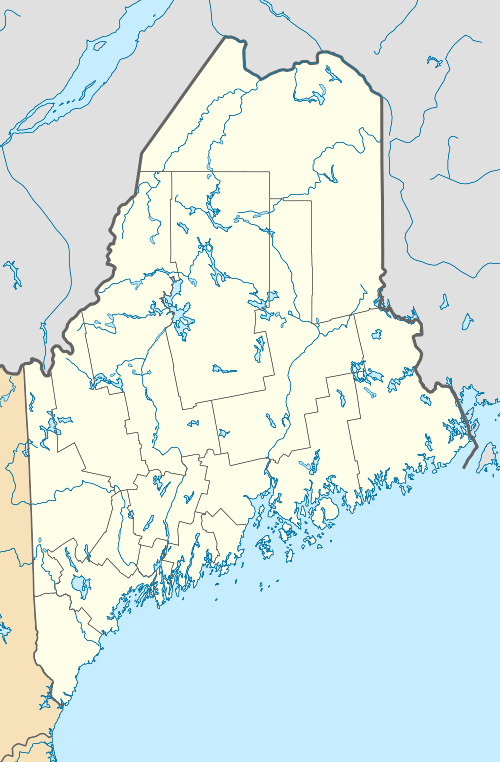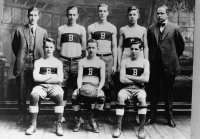Berwick Academy (Maine)
| Berwick Academy | |
|---|---|
|
| |
| Location | |
|
South Berwick, Maine United States | |
| Coordinates | 43°13′50″N 70°48′15″W / 43.23056°N 70.80417°WCoordinates: 43°13′50″N 70°48′15″W / 43.23056°N 70.80417°W |
| Information | |
| Type | Private, Day |
| Religious affiliation(s) | Unaffiliated |
| Established | 1791 |
| Head of School | Gregory Schneider |
| Enrollment | 592 |
| Campus | Semi-Rural, 72 acres (29 ha), 11 Buildings |
| Color(s) | Blue and White |
| Athletics conference | Eastern Independent League |
| Mascot | Bulldog |
| Rivals | Pingree School |
| Website | |
|
Berwick Academy | |
|
Fogg Memorial Building | |
  | |
| Location | Academy St., South Berwick, Maine |
| Area | 81 acres (33 ha) |
| Built | 2010 |
| Architectural style | Richardsonian Romanesque, Victorian, Federal, Colonial Revival |
| NRHP Reference # |
78000336[1] (original) 10000058 (increase) |
| Significant dates | |
| Added to NRHP | March 29, 1978 |
| Boundary increase | March 22, 1996 |
Berwick Academy is a college preparatory school located in South Berwick, Maine. Founded in 1791, it is the oldest educational institution in Maine and one of the oldest private schools in North America. The school sits on a 72-acre, 11-building campus on a hill overlooking the Salmon Falls River, near the border between Maine and New Hampshire. Approximately 565 students in grades Pre-K through 12 (and Post-Grad) attend this coeducational day school, from approximately 60 communities in the surrounding regions of southern Maine, southeastern New Hampshire and northeastern Massachusetts.
History

Berwick Academy was founded in 1791 when citizens of Berwick, York, and Wells (then villages in the District of Maine within Massachusetts) raised $500 to teach languages, liberal arts and sciences to "the youth in this part of the country." Chartered by Massachusetts Governor John Hancock later that year and armed with a classical educational mission, the school opened in a small hip-roofed Georgian building on land donated by Judge Benjamin Chadbournes. The building, named the 1791 House, is the oldest school building in the United States that is still utilized today (Though the building has been relocated since it was built).
From its founding the school contracted with the town of South Berwick to educate local students, serving both as a private college preparatory school and the de facto public school for the town. As the town grew and industrialized, the school's dual role necessitated campus expansion. A second Academy building (1830) was destroyed by fire in 1851; its successor, designed by architect Richard Upjohn, was itself superseded by the William Hayes Fogg Memorial Building. Built in 1894 by George Albert Clough in the Richardsonian Romanesque style, landscaped by Frederick Law Olmsted, and built complete with electricity and state-of-the-art science labs, it remains the main Academy building today serving the majority of Upper School English, history, and foreign language classrooms (science and mathematics are taught in the Jeppesen Science and Math center).
In 1955, the contract with South Berwick terminated and the school reverted to a purely private "prep school," featuring boarding for boys, a day department for girls, and college preparation on a classical model for both. Considerable physical expansion during this period included the acquisitions of surrounding homes for dormitories and of adjacent lands for playing fields.
In the 1970s, the burdensome cost of housing students and the increasing suburbanization of northern New England dictated a further transformation from boarding academy to country day school. A Middle School was founded in 1971 and a Lower School in 1977; boarding was discontinued in 1976 and the dormitory-homes sold or converted to educational uses. In the subsequent decades the school's enrollment, endowment and physical plant have steadily increased. The school has come to occupy a unique academic position in between the 18th century American college preparatory school and the 19th Century progressive country day school – although it predates, sometimes by more than a century, most schools of either movement.


Organization
Berwick is governed by a 23-member Board of Trustees, with a Head of School in charge of fundraising and the day-to-day operation of the Academy. The three subsidiary schools are headed by Division Directors. The Middle School includes a Dean of Students and the Upper School has advisors, class advisors, Grade Deans and an Assistant Director.
Academics

The Academy is divided into three schools: the Lower School (grades PreK–4), the Middle School (grades 5–8) and the Upper School (grades 9–PG). The academic calendar is divided into trimesters; students typically take year-long classes, with some trimester-length elective classes in the Upper School. Students follow a rigorous academic program combining classical education and technology. Berwick has a student-teacher ratio of 8:1 and an average class size of 14 students. In keeping with the school's classical mission subjects of study are diverse and include Liberal Arts, Sciences, Fine Arts, Music and Mathematics. The Berwick curriculum balances tradition with innovation and prepares students for college while ensuring they become ethical citizens that possess "virtue and useful knowledge."
College placement
Berwick Academy has traditionally prepared students for Bowdoin, Dartmouth, Colby and Bates colleges. While these relationships have continued, graduates now matriculate at a wide variety of highly selective colleges in the United States, including the Ivy League, the Little Ivies and the Ancient Universities.
Athletics
Participation in sports is generally required for grade advancement. Middle School students are required to play three sports (an activity like "maker space" will also satisfy this requirement) during their course of study (one for each trimester), and participation in interscholastic athletics is required of Upper School students for at least one trimester per year. Waivers are given to Upper School students participating in a sport not offered at the school. Other after-school extracurricular activities, such as drama, dance, robotics, or independent research projects through the "Innovation Center", are offered as well. Lower school students participate in intramural sports.
Berwick currently fields teams in Golf, Soccer, Field Hockey, Cross Country, Hockey, Basketball, Swimming, Lacrosse, Softball, Tennis, Baseball and Rowing. Teams compete in the Eastern Independent League (EIL) and New England Preparatory School Athletic Council (NEPSAC) are divided by gender and skill level.
When future major league baseball player Sam Fuld attended Berwick Academy as an eighth grader, he made the high school varsity, and the University of New Hampshire's baseball coach opined that he had the best batting swing of any player in the State.[2][3] He was the team's MVP, and a league All Star.[2]
Awards and recognition
- In 2011, a student was selected as a winner of the Arts Olympiad to represent the state of Maine. A few other students were also invited to participate in the workshops at the World Children's Festival.[4]
- In 2011 a team of seventh and eighth grade students won first place in the international Odyssey of the Mind competition, and bested teams from all over the globe.
- In 2013 Berwick Academy's innovation center placed third in the Follett Challenge and the school's library won $30,000 in prize money.
Notable alumni
- John Holmes Burleigh (1822–77), U.S. Congressman from Maine.
- John Noble Goodwin (1824–87) U.S. Congressman from Maine, Congressional Delegate from Arizona Territory, Chief Justice of Arizona Territory, and the first governor of Arizona.
- Sarah Orne Jewett (1849–1909), novelist, author of A Country Doctor (1884), The Country of the Pointed Firs (1896).
- Gladys Hasty Carroll (1904–99), novelist, author of As The Earth Turns (1933) and Dunnybrook (1943).
- Casey Coleman (1951–2006), radio broadcaster and play-by-by announcer for the Cleveland Indians.
- Mike Eruzione (b. 1954), former National Hockey League player and captain of the 1980 U.S. Olympic Hockey Team.
- Sam Fuld (b. 1981), Major League Baseball player for the Oakland Athletics, attended in 8th grade.
References
- ↑ National Park Service (2010-07-09). "National Register Information System". National Register of Historic Places. National Park Service.
- 1 2 Anthony Castrovince. "Fuld an easy underdog to pull for". mlb.com. Retrieved April 25, 2011.
- ↑ Kepner, Tyler (April 19, 2011). "Sam Fuld's Value to the Rays Goes Beyond Numbers". The New York Times.
- ↑ "Berwick Academy selected to represent Maine at World Children's Festival". Fosters Daily Democrat. March 11, 2011. Retrieved January 8, 2013.
| Wikimedia Commons has media related to Berwick Academy (Maine). |

